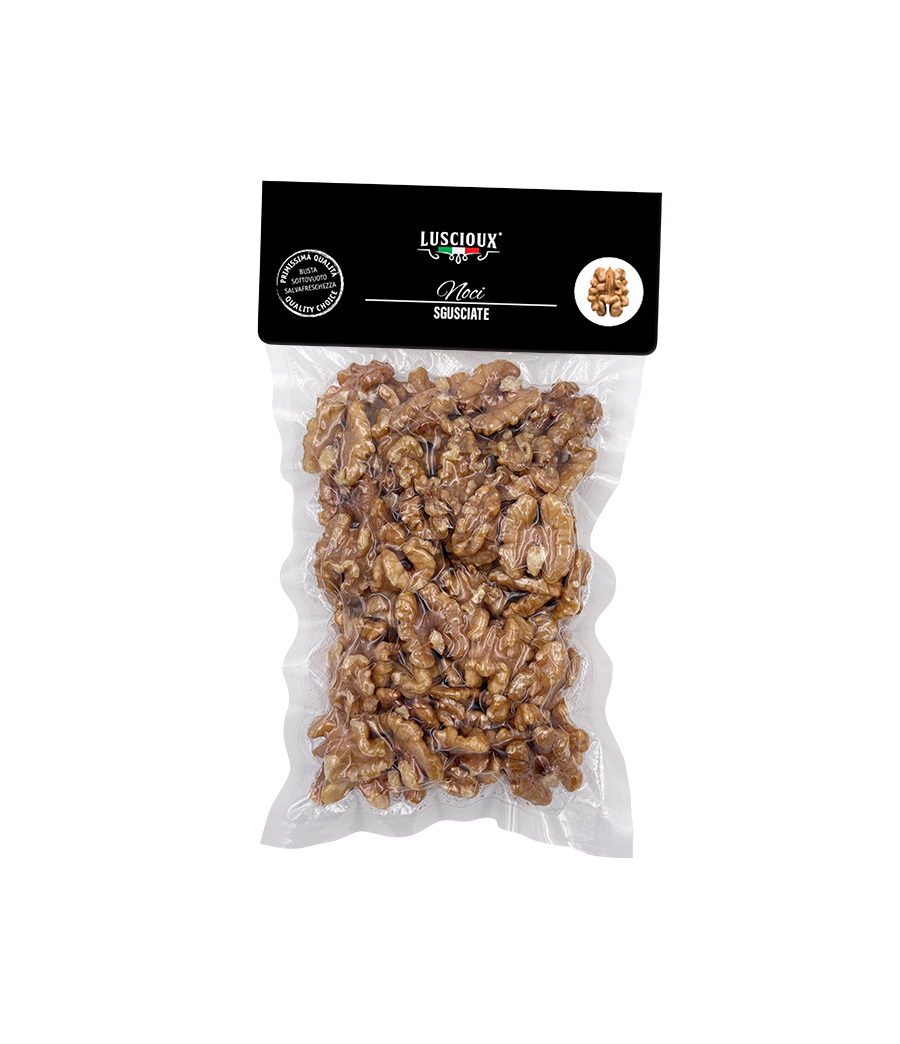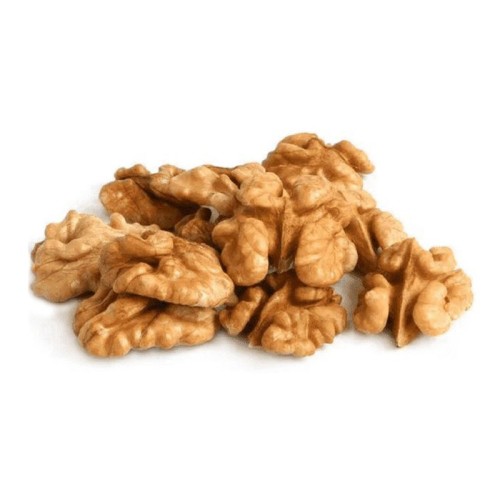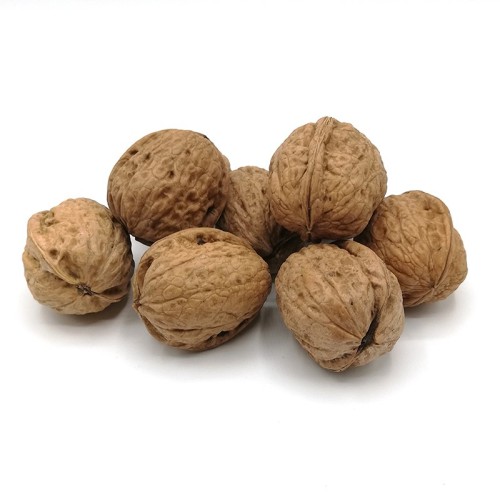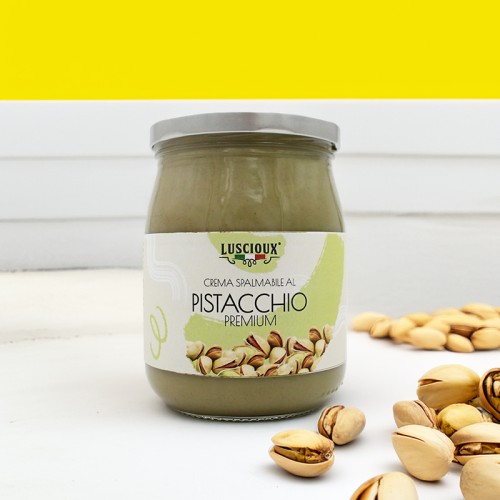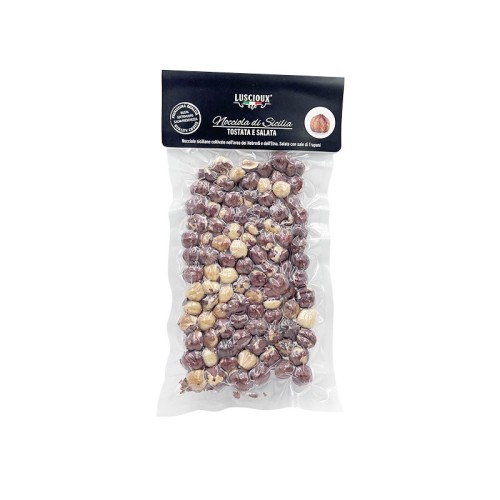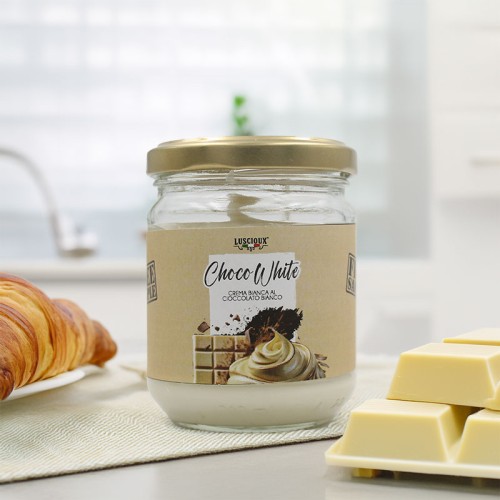Shelled Walnuts Vacuum bag of 150 g
Shelled walnuts are a very energetic fruit, rich in proteins, monounsaturated fats and minerals. They are very popular in the kitchen as they are versatile.
 Security policy
Security policy
Transparency and reliability - Encrypted information (SSL Certificate)
 Delivery policy
Delivery policy
Fast shipping with delivery in 1- 4 working days.
 Return policy
Return policy
24/7
Shelled walnuts are a very energetic fruit, rich in proteins and monounsaturated fats, as well as minerals such as calcium, phosphorus, potassium and magnesium. Walnuts promote vital functions (thanks to zinc which improves vitamin activity) and cholesterol lowering (through unsaturated fatty acids). They also help strengthen bones.
Walnuts are much loved in the kitchen because they are extremely versatile: from the famous nut cream for first courses to delicious cakes, from fillings to pestos. Eat plain for a healthy snack or covered in chocolate for the pleasure of a delicious treat. Finally, a characteristic liqueur is obtained from the walnut hull: the nocino.
Data sheet
- Product
- Walnuts
Specific References
- ean13
- 8054134418851
Nutritional values
| Ingredients | Ingredients: NUTS. May contain traces of PEANUTS and other NUTS. |
| Method of conservation | Keep in a cold and dry place. |
| Nutrition declaration | average values per 100 g: |
| Power | 2919 kJ / 706 kcal |
| Fats | 65 g |
| of which saturated fatty acids | 5.9g |
| Carbohydrates | 9.9g |
| of which sugars | 2.4g |
| Fibers | 4.9g |
| Protein | 18 g |
| Salt | 0 g |
| Copper | 1.5 mg (150% NRV*) |
| Manganese | 2.1 mg (105% NRV*) |
| Vitamin E | 150 μg (75% NRV*) |
| Directions | The advice given IS NOT IN ANY WAY TO BE CONSIDERED OF MEDICAL/PRESCRIPTIVE VALUE. The information provided is for informational and informative purposes only, therefore they are not intended in any way to replace medical advice. In the presence of pathologies you should always consult your doctor. |
| Origin | Italy |
| Nutrients | Folacin, Manganese, Copper |
| Vnr | *Nutritional Reference Value |
| Label and packaging | The images are included for illustrative purposes, the product may undergo changes based on stock availability and the selected weight. |
| Product | Nuts |
Curiosity
Commonly known as walnuts, Juglans is a genus of plants in the Juglandaceae family.
The walnut is a deciduous tree, with a height of between 10 and 40 metres, with pinnate leaves 200-900 mm long, with 5-25 leaflets. The best known species is Juglans regia, known as fruit nut or white nut. The natural range includes North and South America, Asia and Europe. The fruit , the walnut, is an ovoid-shaped drupe covered by a green hull that is initially green, then black when ripe. The shell has a woody and leathery appearance, inside which the edible part is contained: the kernel with a high lipid content.
The harvest , which varies according to the areas and cultivars, begins at the end of August and continues until November. It usually begins when the nut husk is cracked, but not completely open, otherwise the shell will blacken. In Italy the harvest is mostly carried out with the beating down, that is using long poles with which the fruits are struck; in California, on the other hand, all harvesting operations are highly mechanized and the nuts are removed from the tree using a mechanical shaker.
Among nuts, the walnut ranks second in the world for diffusion and cultivation (Fao Stat, 2008). The world's largest producers of walnuts are China , the United States and Turkey . California alone produces about 2/3 of the nuts traded in the world.
Walnuts are consumed both fresh and in culinary preparations, for desserts, sauces and baked goods. An excellent liqueur is also prepared with walnuts: the nocino.
In Jammu (India), nuts are widely used as an offering to the Mother Goddess Vaisnav Devi and are generally used as dry food in the festive season. Walnuts are a traditional feature of Iranian cuisine.
Among the animals fond of nuts we mention the crows which, in order to eat the kernel, drop the nuts from a great height onto a hard surface, in order to open them and feed on the contents.
Walnut leaves and husks are used in popular medicine and in the pharmaceutical industry for their bitter, tonic and astringent properties, against dyspepsia and inflammation of the gastrointestinal tract. Astringent baths are prepared with the infused leaves.
Walnuts contain mostly monounsaturated fats defined as "good" ; this characteristic makes walnuts beneficial for the cardiovascular system. Good fats have the ability to reduce bad cholesterol (LDL) levels and raise good cholesterol (HDL) levels. They also contain a significant amount of arginine, which is very beneficial for arterial and heart health.
According to the EU regulation n. 432/2012, walnuts contribute to the improvement of the elasticity of blood vessels.
Sources:
Nutspaper “The walnut” 4/2013
History
The name of the genus comes from the Latin Jovis, which means Jupiter; and Glans, meaning acorn: the Acorn of Jupiter .
Species similar to the walnut have been found in stratifications belonging to the Miocene geological era. Archaeological finds indicate that the walnut fruits were used as food already 9000 years ago. The plant is in fact known and cultivated in the most ancient European and Asian civilizations.
Many scholars have conducted research to establish the area of origin of the species: the most accredited hypothesis is that the walnut originates from China or from the Himalayan massif .
The walnut was spread in the West by the Greeks and then by the Romans, for whom this fruit was a symbol of fertility and was distributed during wedding ceremonies. The same mythology also traces its knowledge back to the Gods: in fact, it is said that Jupiter himself used it in his banquets on Olympus.
The diffusion of the walnut in Europe as a cultivated tree is the work of the Romans, whose legions brought the plant to the areas of the Moselle and the Rhine, as well as to Spain, France and England.
The major Latin poets speak of the walnut, including Virgil and Ovid. In the archaeological excavations of Pompeii and Herculaneum carbonized walnuts were found with characteristics similar to those of the Sorrento variety.
One of the legends concerning the walnut says that witches gathered in its shade and therefore its shadow was harmful to men and animals.
Sources:
Nutspaper “The walnut” 4/2013
storage
You can store shelled walnuts in cool, dry places, away from sources of heat and humidity. Here are 4 useful tips:
- The ideal condition for keeping shelled walnuts is in a refrigerated environment . Shelled walnuts can also be stored without problems at room temperature during the winter season given the low temperatures. During the summer, on the other hand, it is advisable to keep it in the fridge or in the coolest possible places, as the increase in temperatures could favor the deterioration of the products.
- The ideal container in which to store shelled walnuts is glass . In fact, thanks to its constitution it is impenetrable to chemical and gaseous agents, and having excellent thermal insulating capacity it maintains the initial temperature for a longer time compared to other materials. If the glass is colored, all the better: using colored glass prevents the entry of some wavelengths of light (including ultraviolet light) and therefore some nutritional and organoleptic characteristics remain unaltered.
- The type of closure of the container is also important: an airtight cap ensures that the food is protected from excessive contact with oxygen which can lead to lipid oxidation and which can be essential for aerobic bacteria.
- The environment should always be well ventilated : by ventilating the rooms, the internal humidity that escapes from the window is kept under control, guaranteeing the right balance, which helps to discourage the onset of moulds.
Recommended doses
30 g of shelled walnuts provide:
- 39% of the nutritional reference value of Copper;
- 32% of the nutritional reference value of Manganese;
- 23% of the nutritional reference value of Vitamin E.
Property
100g of shelled walnuts contain:
- Potassium (363 mg - 18% NRV)
- Iron (3.0 mg - 21% NRV)
- Zinc (2.6 mg - 26% NRV)
- Vitamin B6 (0.39 mg - 28% NRV)
- Magnesium (134 mg - 36% NRV)
- Phosphorus (322 mg - 46% NRV)
- Vitamin E (9.1 mg - 76% NRV)
- Manganese (2.1 mg - 105% NRV)
- Copper (1.3 mg - 130% NRV)
- Fiber (6.7 g)
- Unsaturated fatty acids (59 g), polyunsaturated (46 g) and oleic acid (13 g)
- Linoleic acid (36 g)
- Alpha-linolenic acid (9.2 g)
Please note that walnuts are included in the list of allergens (Annex 2 EU Reg. 1169/2011 and subsequent amendments)
No customer reviews for the moment.

